Applied Management Theory: Organizational Culture Analysis Report
VerifiedAdded on 2022/10/01
|11
|2879
|25
Report
AI Summary
This report delves into the concept of organizational culture, defining it as the values and behaviors shaping a company's environment and influencing its long-term success. It explores the contributors to organizational culture, including leadership styles, organizational structure, and risk-taking attitudes. The report highlights the crucial link between organizational culture and the ability to meet business objectives, emphasizing the importance of employee involvement and adaptability. It also examines the McKinsey 7S model, illustrating the connection between various organizational elements and culture. Furthermore, the report discusses the significance of organizational culture in modern contexts, emphasizing its role in defining a company's identity, retaining top talent, fostering teamwork, and impacting performance and employee well-being. Finally, the report analyzes different types of organizational culture, such as clan and market cultures, along with their respective advantages and disadvantages concerning organizational effectiveness, providing insights into how these cultures impact organizational dynamics and outcomes. The report is contributed by a student to be published on the website Desklib.

Applied Management Theory
Paraphrase This Document
Need a fresh take? Get an instant paraphrase of this document with our AI Paraphraser

TABLE OF CONTENTS
INTRODUCTION...........................................................................................................................1
Concept of organizational culture................................................................................................1
Contributors to organizational culture.........................................................................................1
Link between culture of organization and its capacity in order to meet the objectives...............2
Link between various organizational elements and the culture of an organization.....................2
Reasons through which organizational culture become significant in modern organizations.....4
Different types of culture and their advantages and disadvantages to organizational
effectiveness.................................................................................................................................5
CONCLUSION................................................................................................................................7
REFERENCES................................................................................................................................8
INTRODUCTION...........................................................................................................................1
Concept of organizational culture................................................................................................1
Contributors to organizational culture.........................................................................................1
Link between culture of organization and its capacity in order to meet the objectives...............2
Link between various organizational elements and the culture of an organization.....................2
Reasons through which organizational culture become significant in modern organizations.....4
Different types of culture and their advantages and disadvantages to organizational
effectiveness.................................................................................................................................5
CONCLUSION................................................................................................................................7
REFERENCES................................................................................................................................8
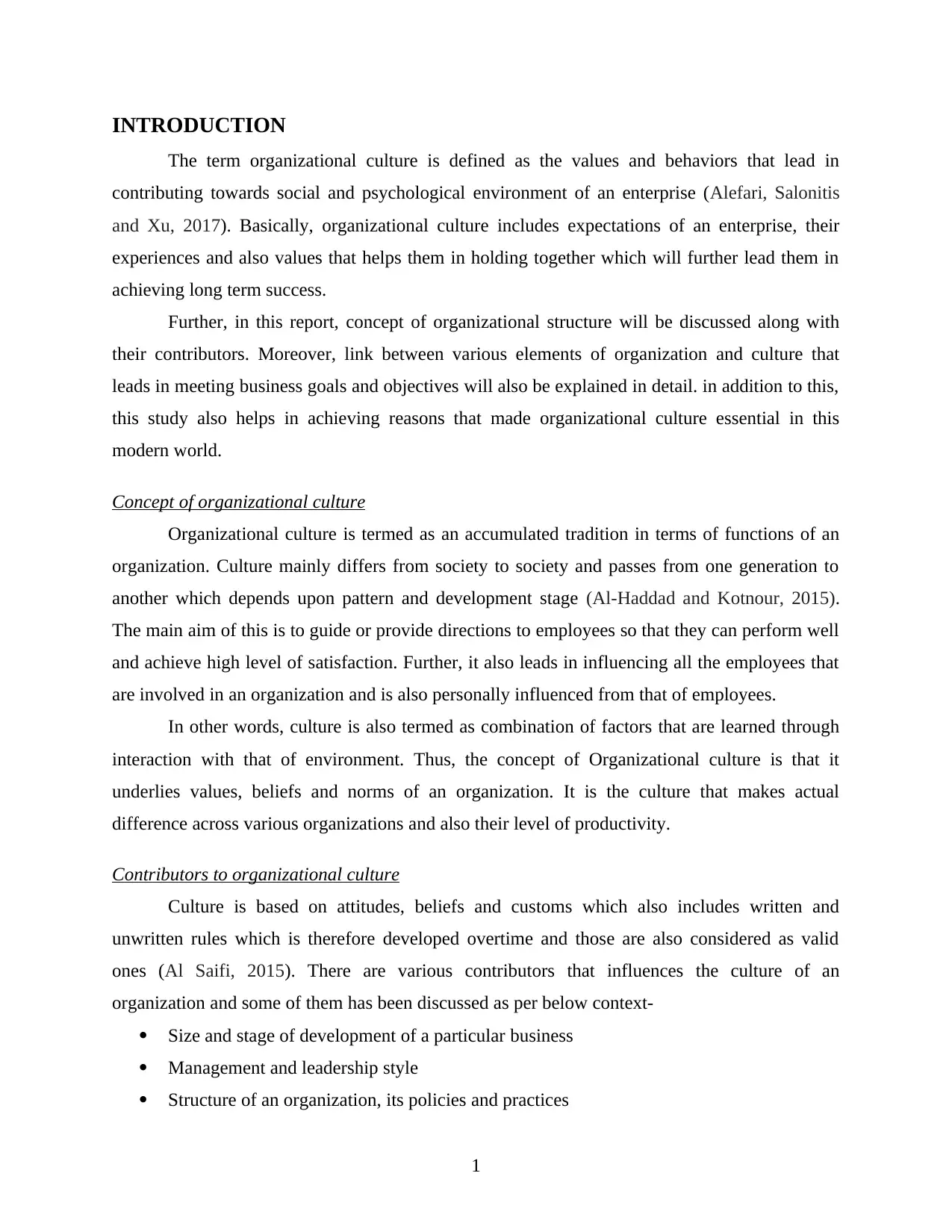
INTRODUCTION
The term organizational culture is defined as the values and behaviors that lead in
contributing towards social and psychological environment of an enterprise (Alefari, Salonitis
and Xu, 2017). Basically, organizational culture includes expectations of an enterprise, their
experiences and also values that helps them in holding together which will further lead them in
achieving long term success.
Further, in this report, concept of organizational structure will be discussed along with
their contributors. Moreover, link between various elements of organization and culture that
leads in meeting business goals and objectives will also be explained in detail. in addition to this,
this study also helps in achieving reasons that made organizational culture essential in this
modern world.
Concept of organizational culture
Organizational culture is termed as an accumulated tradition in terms of functions of an
organization. Culture mainly differs from society to society and passes from one generation to
another which depends upon pattern and development stage (Al-Haddad and Kotnour, 2015).
The main aim of this is to guide or provide directions to employees so that they can perform well
and achieve high level of satisfaction. Further, it also leads in influencing all the employees that
are involved in an organization and is also personally influenced from that of employees.
In other words, culture is also termed as combination of factors that are learned through
interaction with that of environment. Thus, the concept of Organizational culture is that it
underlies values, beliefs and norms of an organization. It is the culture that makes actual
difference across various organizations and also their level of productivity.
Contributors to organizational culture
Culture is based on attitudes, beliefs and customs which also includes written and
unwritten rules which is therefore developed overtime and those are also considered as valid
ones (Al Saifi, 2015). There are various contributors that influences the culture of an
organization and some of them has been discussed as per below context-
Size and stage of development of a particular business
Management and leadership style
Structure of an organization, its policies and practices
1
The term organizational culture is defined as the values and behaviors that lead in
contributing towards social and psychological environment of an enterprise (Alefari, Salonitis
and Xu, 2017). Basically, organizational culture includes expectations of an enterprise, their
experiences and also values that helps them in holding together which will further lead them in
achieving long term success.
Further, in this report, concept of organizational structure will be discussed along with
their contributors. Moreover, link between various elements of organization and culture that
leads in meeting business goals and objectives will also be explained in detail. in addition to this,
this study also helps in achieving reasons that made organizational culture essential in this
modern world.
Concept of organizational culture
Organizational culture is termed as an accumulated tradition in terms of functions of an
organization. Culture mainly differs from society to society and passes from one generation to
another which depends upon pattern and development stage (Al-Haddad and Kotnour, 2015).
The main aim of this is to guide or provide directions to employees so that they can perform well
and achieve high level of satisfaction. Further, it also leads in influencing all the employees that
are involved in an organization and is also personally influenced from that of employees.
In other words, culture is also termed as combination of factors that are learned through
interaction with that of environment. Thus, the concept of Organizational culture is that it
underlies values, beliefs and norms of an organization. It is the culture that makes actual
difference across various organizations and also their level of productivity.
Contributors to organizational culture
Culture is based on attitudes, beliefs and customs which also includes written and
unwritten rules which is therefore developed overtime and those are also considered as valid
ones (Al Saifi, 2015). There are various contributors that influences the culture of an
organization and some of them has been discussed as per below context-
Size and stage of development of a particular business
Management and leadership style
Structure of an organization, its policies and practices
1
⊘ This is a preview!⊘
Do you want full access?
Subscribe today to unlock all pages.

Trusted by 1+ million students worldwide
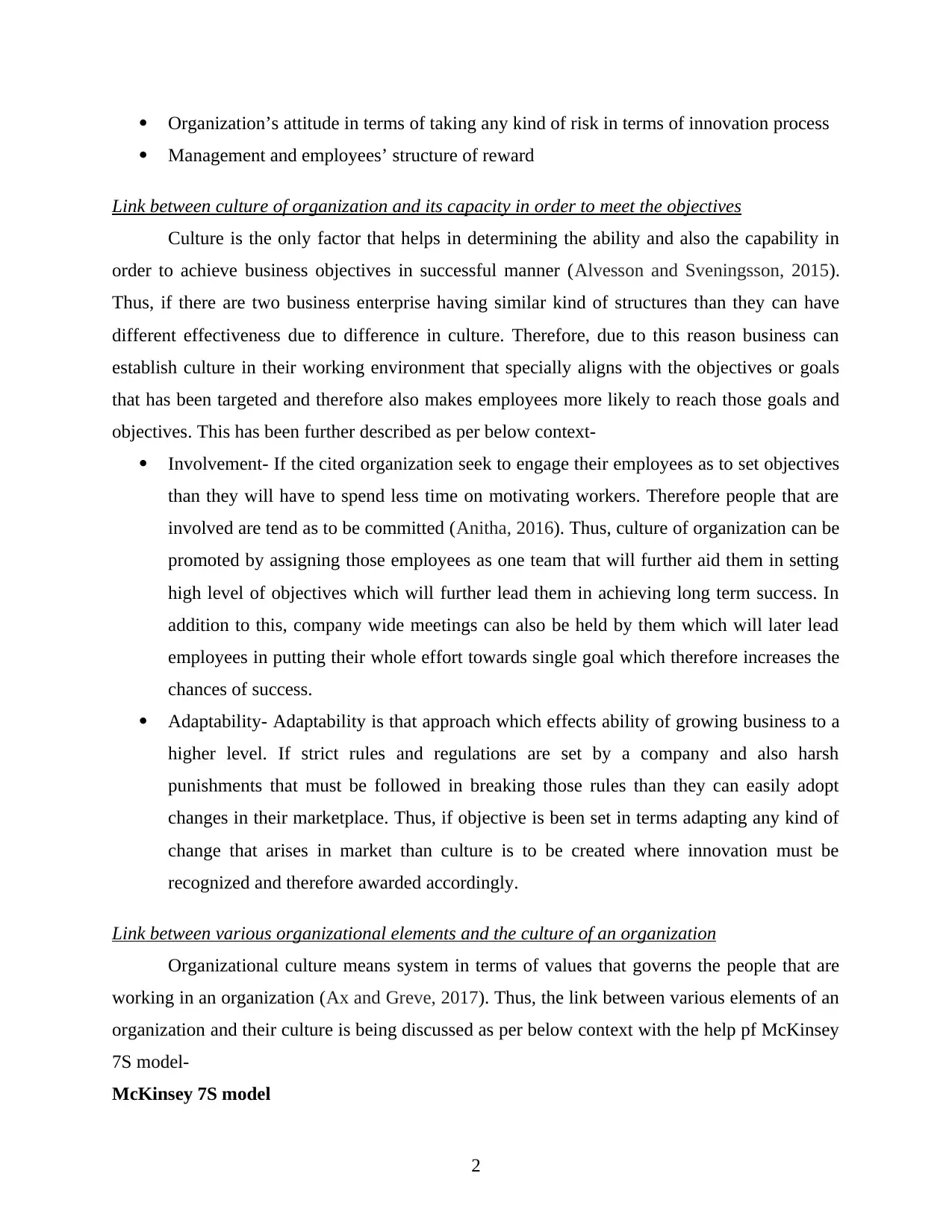
Organization’s attitude in terms of taking any kind of risk in terms of innovation process
Management and employees’ structure of reward
Link between culture of organization and its capacity in order to meet the objectives
Culture is the only factor that helps in determining the ability and also the capability in
order to achieve business objectives in successful manner (Alvesson and Sveningsson, 2015).
Thus, if there are two business enterprise having similar kind of structures than they can have
different effectiveness due to difference in culture. Therefore, due to this reason business can
establish culture in their working environment that specially aligns with the objectives or goals
that has been targeted and therefore also makes employees more likely to reach those goals and
objectives. This has been further described as per below context-
Involvement- If the cited organization seek to engage their employees as to set objectives
than they will have to spend less time on motivating workers. Therefore people that are
involved are tend as to be committed (Anitha, 2016). Thus, culture of organization can be
promoted by assigning those employees as one team that will further aid them in setting
high level of objectives which will further lead them in achieving long term success. In
addition to this, company wide meetings can also be held by them which will later lead
employees in putting their whole effort towards single goal which therefore increases the
chances of success.
Adaptability- Adaptability is that approach which effects ability of growing business to a
higher level. If strict rules and regulations are set by a company and also harsh
punishments that must be followed in breaking those rules than they can easily adopt
changes in their marketplace. Thus, if objective is been set in terms adapting any kind of
change that arises in market than culture is to be created where innovation must be
recognized and therefore awarded accordingly.
Link between various organizational elements and the culture of an organization
Organizational culture means system in terms of values that governs the people that are
working in an organization (Ax and Greve, 2017). Thus, the link between various elements of an
organization and their culture is being discussed as per below context with the help pf McKinsey
7S model-
McKinsey 7S model
2
Management and employees’ structure of reward
Link between culture of organization and its capacity in order to meet the objectives
Culture is the only factor that helps in determining the ability and also the capability in
order to achieve business objectives in successful manner (Alvesson and Sveningsson, 2015).
Thus, if there are two business enterprise having similar kind of structures than they can have
different effectiveness due to difference in culture. Therefore, due to this reason business can
establish culture in their working environment that specially aligns with the objectives or goals
that has been targeted and therefore also makes employees more likely to reach those goals and
objectives. This has been further described as per below context-
Involvement- If the cited organization seek to engage their employees as to set objectives
than they will have to spend less time on motivating workers. Therefore people that are
involved are tend as to be committed (Anitha, 2016). Thus, culture of organization can be
promoted by assigning those employees as one team that will further aid them in setting
high level of objectives which will further lead them in achieving long term success. In
addition to this, company wide meetings can also be held by them which will later lead
employees in putting their whole effort towards single goal which therefore increases the
chances of success.
Adaptability- Adaptability is that approach which effects ability of growing business to a
higher level. If strict rules and regulations are set by a company and also harsh
punishments that must be followed in breaking those rules than they can easily adopt
changes in their marketplace. Thus, if objective is been set in terms adapting any kind of
change that arises in market than culture is to be created where innovation must be
recognized and therefore awarded accordingly.
Link between various organizational elements and the culture of an organization
Organizational culture means system in terms of values that governs the people that are
working in an organization (Ax and Greve, 2017). Thus, the link between various elements of an
organization and their culture is being discussed as per below context with the help pf McKinsey
7S model-
McKinsey 7S model
2
Paraphrase This Document
Need a fresh take? Get an instant paraphrase of this document with our AI Paraphraser
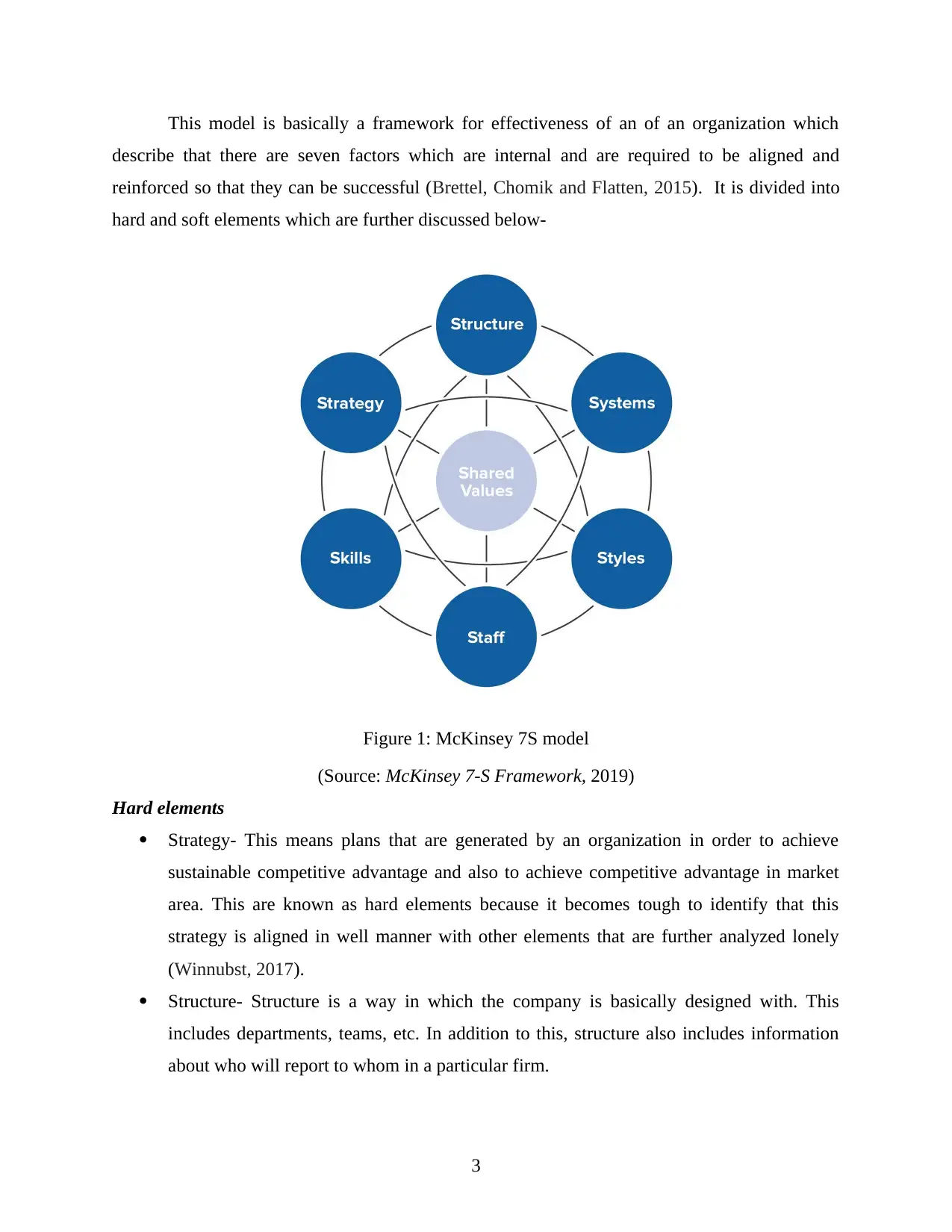
This model is basically a framework for effectiveness of an of an organization which
describe that there are seven factors which are internal and are required to be aligned and
reinforced so that they can be successful (Brettel, Chomik and Flatten, 2015). It is divided into
hard and soft elements which are further discussed below-
Figure 1: McKinsey 7S model
(Source: McKinsey 7-S Framework, 2019)
Hard elements
Strategy- This means plans that are generated by an organization in order to achieve
sustainable competitive advantage and also to achieve competitive advantage in market
area. This are known as hard elements because it becomes tough to identify that this
strategy is aligned in well manner with other elements that are further analyzed lonely
(Winnubst, 2017).
Structure- Structure is a way in which the company is basically designed with. This
includes departments, teams, etc. In addition to this, structure also includes information
about who will report to whom in a particular firm.
3
describe that there are seven factors which are internal and are required to be aligned and
reinforced so that they can be successful (Brettel, Chomik and Flatten, 2015). It is divided into
hard and soft elements which are further discussed below-
Figure 1: McKinsey 7S model
(Source: McKinsey 7-S Framework, 2019)
Hard elements
Strategy- This means plans that are generated by an organization in order to achieve
sustainable competitive advantage and also to achieve competitive advantage in market
area. This are known as hard elements because it becomes tough to identify that this
strategy is aligned in well manner with other elements that are further analyzed lonely
(Winnubst, 2017).
Structure- Structure is a way in which the company is basically designed with. This
includes departments, teams, etc. In addition to this, structure also includes information
about who will report to whom in a particular firm.
3
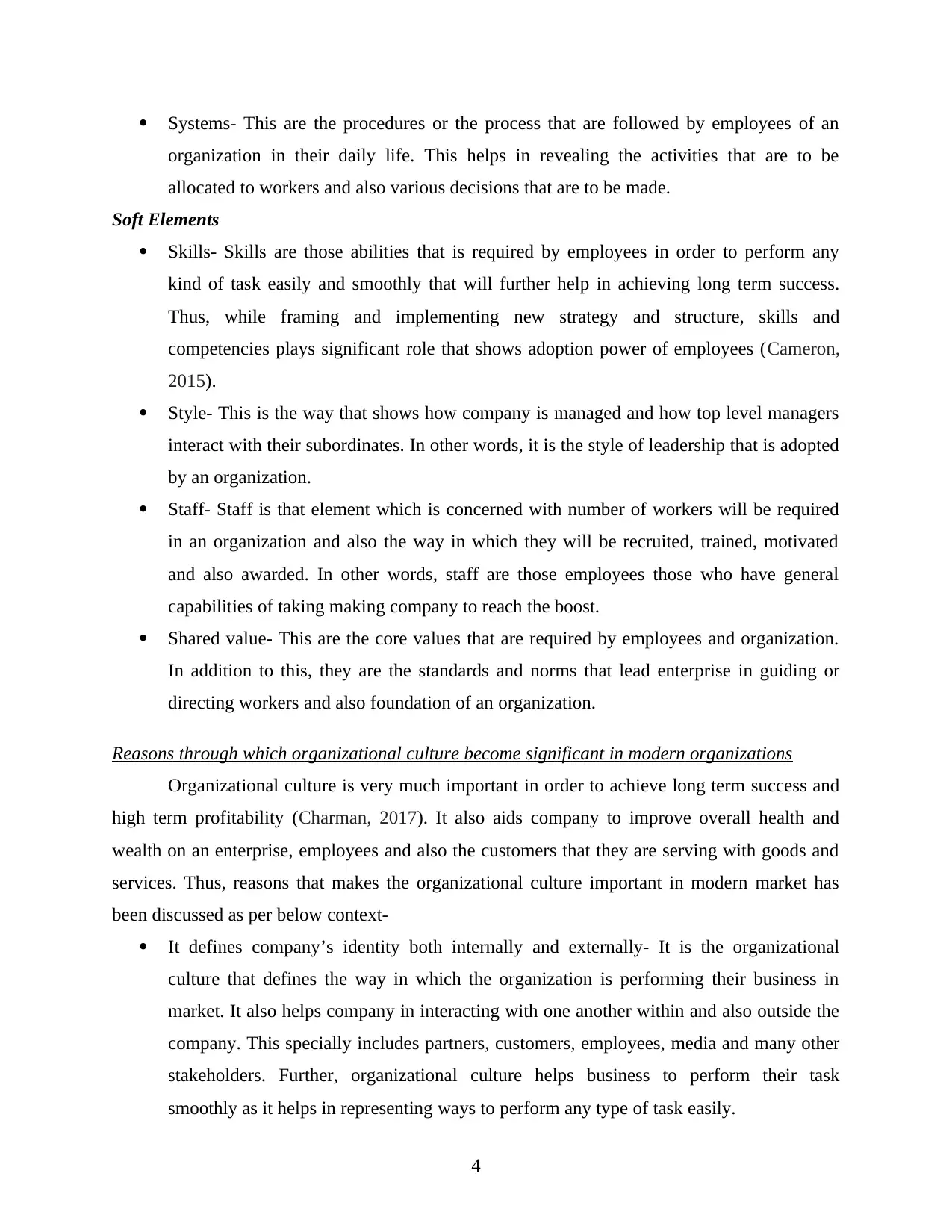
Systems- This are the procedures or the process that are followed by employees of an
organization in their daily life. This helps in revealing the activities that are to be
allocated to workers and also various decisions that are to be made.
Soft Elements
Skills- Skills are those abilities that is required by employees in order to perform any
kind of task easily and smoothly that will further help in achieving long term success.
Thus, while framing and implementing new strategy and structure, skills and
competencies plays significant role that shows adoption power of employees (Cameron,
2015).
Style- This is the way that shows how company is managed and how top level managers
interact with their subordinates. In other words, it is the style of leadership that is adopted
by an organization.
Staff- Staff is that element which is concerned with number of workers will be required
in an organization and also the way in which they will be recruited, trained, motivated
and also awarded. In other words, staff are those employees those who have general
capabilities of taking making company to reach the boost.
Shared value- This are the core values that are required by employees and organization.
In addition to this, they are the standards and norms that lead enterprise in guiding or
directing workers and also foundation of an organization.
Reasons through which organizational culture become significant in modern organizations
Organizational culture is very much important in order to achieve long term success and
high term profitability (Charman, 2017). It also aids company to improve overall health and
wealth on an enterprise, employees and also the customers that they are serving with goods and
services. Thus, reasons that makes the organizational culture important in modern market has
been discussed as per below context-
It defines company’s identity both internally and externally- It is the organizational
culture that defines the way in which the organization is performing their business in
market. It also helps company in interacting with one another within and also outside the
company. This specially includes partners, customers, employees, media and many other
stakeholders. Further, organizational culture helps business to perform their task
smoothly as it helps in representing ways to perform any type of task easily.
4
organization in their daily life. This helps in revealing the activities that are to be
allocated to workers and also various decisions that are to be made.
Soft Elements
Skills- Skills are those abilities that is required by employees in order to perform any
kind of task easily and smoothly that will further help in achieving long term success.
Thus, while framing and implementing new strategy and structure, skills and
competencies plays significant role that shows adoption power of employees (Cameron,
2015).
Style- This is the way that shows how company is managed and how top level managers
interact with their subordinates. In other words, it is the style of leadership that is adopted
by an organization.
Staff- Staff is that element which is concerned with number of workers will be required
in an organization and also the way in which they will be recruited, trained, motivated
and also awarded. In other words, staff are those employees those who have general
capabilities of taking making company to reach the boost.
Shared value- This are the core values that are required by employees and organization.
In addition to this, they are the standards and norms that lead enterprise in guiding or
directing workers and also foundation of an organization.
Reasons through which organizational culture become significant in modern organizations
Organizational culture is very much important in order to achieve long term success and
high term profitability (Charman, 2017). It also aids company to improve overall health and
wealth on an enterprise, employees and also the customers that they are serving with goods and
services. Thus, reasons that makes the organizational culture important in modern market has
been discussed as per below context-
It defines company’s identity both internally and externally- It is the organizational
culture that defines the way in which the organization is performing their business in
market. It also helps company in interacting with one another within and also outside the
company. This specially includes partners, customers, employees, media and many other
stakeholders. Further, organizational culture helps business to perform their task
smoothly as it helps in representing ways to perform any type of task easily.
4
⊘ This is a preview!⊘
Do you want full access?
Subscribe today to unlock all pages.

Trusted by 1+ million students worldwide
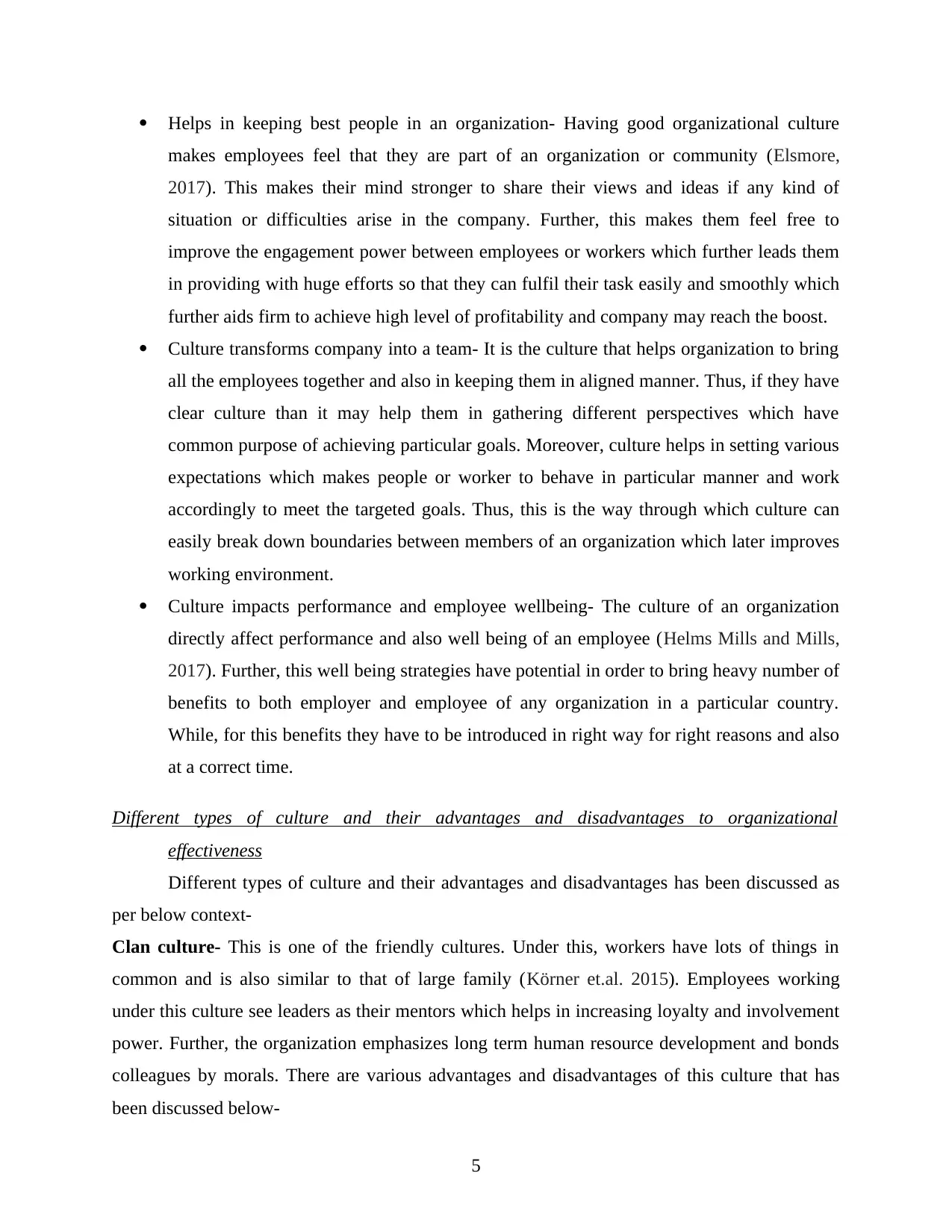
Helps in keeping best people in an organization- Having good organizational culture
makes employees feel that they are part of an organization or community (Elsmore,
2017). This makes their mind stronger to share their views and ideas if any kind of
situation or difficulties arise in the company. Further, this makes them feel free to
improve the engagement power between employees or workers which further leads them
in providing with huge efforts so that they can fulfil their task easily and smoothly which
further aids firm to achieve high level of profitability and company may reach the boost.
Culture transforms company into a team- It is the culture that helps organization to bring
all the employees together and also in keeping them in aligned manner. Thus, if they have
clear culture than it may help them in gathering different perspectives which have
common purpose of achieving particular goals. Moreover, culture helps in setting various
expectations which makes people or worker to behave in particular manner and work
accordingly to meet the targeted goals. Thus, this is the way through which culture can
easily break down boundaries between members of an organization which later improves
working environment.
Culture impacts performance and employee wellbeing- The culture of an organization
directly affect performance and also well being of an employee (Helms Mills and Mills,
2017). Further, this well being strategies have potential in order to bring heavy number of
benefits to both employer and employee of any organization in a particular country.
While, for this benefits they have to be introduced in right way for right reasons and also
at a correct time.
Different types of culture and their advantages and disadvantages to organizational
effectiveness
Different types of culture and their advantages and disadvantages has been discussed as
per below context-
Clan culture- This is one of the friendly cultures. Under this, workers have lots of things in
common and is also similar to that of large family (Körner et.al. 2015). Employees working
under this culture see leaders as their mentors which helps in increasing loyalty and involvement
power. Further, the organization emphasizes long term human resource development and bonds
colleagues by morals. There are various advantages and disadvantages of this culture that has
been discussed below-
5
makes employees feel that they are part of an organization or community (Elsmore,
2017). This makes their mind stronger to share their views and ideas if any kind of
situation or difficulties arise in the company. Further, this makes them feel free to
improve the engagement power between employees or workers which further leads them
in providing with huge efforts so that they can fulfil their task easily and smoothly which
further aids firm to achieve high level of profitability and company may reach the boost.
Culture transforms company into a team- It is the culture that helps organization to bring
all the employees together and also in keeping them in aligned manner. Thus, if they have
clear culture than it may help them in gathering different perspectives which have
common purpose of achieving particular goals. Moreover, culture helps in setting various
expectations which makes people or worker to behave in particular manner and work
accordingly to meet the targeted goals. Thus, this is the way through which culture can
easily break down boundaries between members of an organization which later improves
working environment.
Culture impacts performance and employee wellbeing- The culture of an organization
directly affect performance and also well being of an employee (Helms Mills and Mills,
2017). Further, this well being strategies have potential in order to bring heavy number of
benefits to both employer and employee of any organization in a particular country.
While, for this benefits they have to be introduced in right way for right reasons and also
at a correct time.
Different types of culture and their advantages and disadvantages to organizational
effectiveness
Different types of culture and their advantages and disadvantages has been discussed as
per below context-
Clan culture- This is one of the friendly cultures. Under this, workers have lots of things in
common and is also similar to that of large family (Körner et.al. 2015). Employees working
under this culture see leaders as their mentors which helps in increasing loyalty and involvement
power. Further, the organization emphasizes long term human resource development and bonds
colleagues by morals. There are various advantages and disadvantages of this culture that has
been discussed below-
5
Paraphrase This Document
Need a fresh take? Get an instant paraphrase of this document with our AI Paraphraser

Advantages
Clear communication- If clan culture is adopted by an organization, then it will help
employees to dream and think in similar way which will later lead them in working as a
team. In addition to this, this will also help them in communicating freely with their
views and ideas that would aid organization in achieving long term profitability and
productivity and company may reach the boost success.
Ideas and feedback- As clan culture is a family type culture that adopts more inclusive
approach in terms of welcoming various ideas and also feedbacks either in positive or
negative way. This feedback will further help firm to change their style or structure as
and when need arises.
Disadvantages
Lack of Diversity- If business adopts clan culture, then they tend to be homogeneous
organization. Under this culture, employees become free to share beliefs which may
further make united effort more easier which also robs organization of diversity benefits.
Sometimes it is important to have different pair of eyes to solve one particular problem,
as if all eyes look at the problem in same manner then it would be difficult to find
solution and it will also take time.
Market culture- Under this, the main aim of an organization is only to achieve goals and
objectives that has been targeted (O'Neill, Beauvais and Scholl, 2016). Employees in this are
more concerned on the competition that is taking place in market.
Advantages
It helps in maximizing profit
It drives employees towards particular ambition.
It is always one step ahead
Ready to react to any change in market which help in ensuring that market shares are
maintained accordingly.
Disadvantage
They need to stay in tune with surrounding market as if they can reach any changes that
suddenly arise in market.
Highly competitive working environment makes employees adopt dishonest working
environment as it is all based on competition.
6
Clear communication- If clan culture is adopted by an organization, then it will help
employees to dream and think in similar way which will later lead them in working as a
team. In addition to this, this will also help them in communicating freely with their
views and ideas that would aid organization in achieving long term profitability and
productivity and company may reach the boost success.
Ideas and feedback- As clan culture is a family type culture that adopts more inclusive
approach in terms of welcoming various ideas and also feedbacks either in positive or
negative way. This feedback will further help firm to change their style or structure as
and when need arises.
Disadvantages
Lack of Diversity- If business adopts clan culture, then they tend to be homogeneous
organization. Under this culture, employees become free to share beliefs which may
further make united effort more easier which also robs organization of diversity benefits.
Sometimes it is important to have different pair of eyes to solve one particular problem,
as if all eyes look at the problem in same manner then it would be difficult to find
solution and it will also take time.
Market culture- Under this, the main aim of an organization is only to achieve goals and
objectives that has been targeted (O'Neill, Beauvais and Scholl, 2016). Employees in this are
more concerned on the competition that is taking place in market.
Advantages
It helps in maximizing profit
It drives employees towards particular ambition.
It is always one step ahead
Ready to react to any change in market which help in ensuring that market shares are
maintained accordingly.
Disadvantage
They need to stay in tune with surrounding market as if they can reach any changes that
suddenly arise in market.
Highly competitive working environment makes employees adopt dishonest working
environment as it is all based on competition.
6
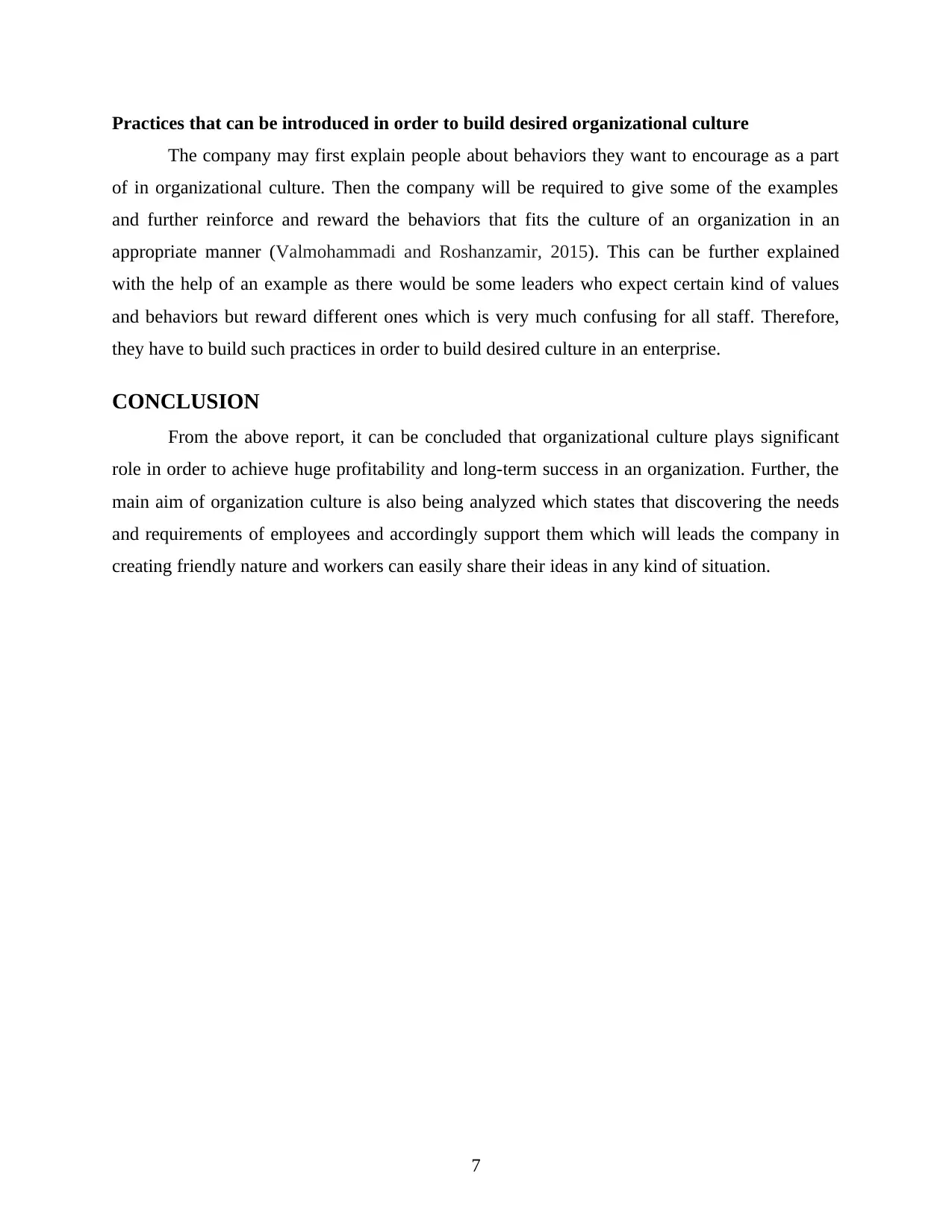
Practices that can be introduced in order to build desired organizational culture
The company may first explain people about behaviors they want to encourage as a part
of in organizational culture. Then the company will be required to give some of the examples
and further reinforce and reward the behaviors that fits the culture of an organization in an
appropriate manner (Valmohammadi and Roshanzamir, 2015). This can be further explained
with the help of an example as there would be some leaders who expect certain kind of values
and behaviors but reward different ones which is very much confusing for all staff. Therefore,
they have to build such practices in order to build desired culture in an enterprise.
CONCLUSION
From the above report, it can be concluded that organizational culture plays significant
role in order to achieve huge profitability and long-term success in an organization. Further, the
main aim of organization culture is also being analyzed which states that discovering the needs
and requirements of employees and accordingly support them which will leads the company in
creating friendly nature and workers can easily share their ideas in any kind of situation.
7
The company may first explain people about behaviors they want to encourage as a part
of in organizational culture. Then the company will be required to give some of the examples
and further reinforce and reward the behaviors that fits the culture of an organization in an
appropriate manner (Valmohammadi and Roshanzamir, 2015). This can be further explained
with the help of an example as there would be some leaders who expect certain kind of values
and behaviors but reward different ones which is very much confusing for all staff. Therefore,
they have to build such practices in order to build desired culture in an enterprise.
CONCLUSION
From the above report, it can be concluded that organizational culture plays significant
role in order to achieve huge profitability and long-term success in an organization. Further, the
main aim of organization culture is also being analyzed which states that discovering the needs
and requirements of employees and accordingly support them which will leads the company in
creating friendly nature and workers can easily share their ideas in any kind of situation.
7
⊘ This is a preview!⊘
Do you want full access?
Subscribe today to unlock all pages.

Trusted by 1+ million students worldwide
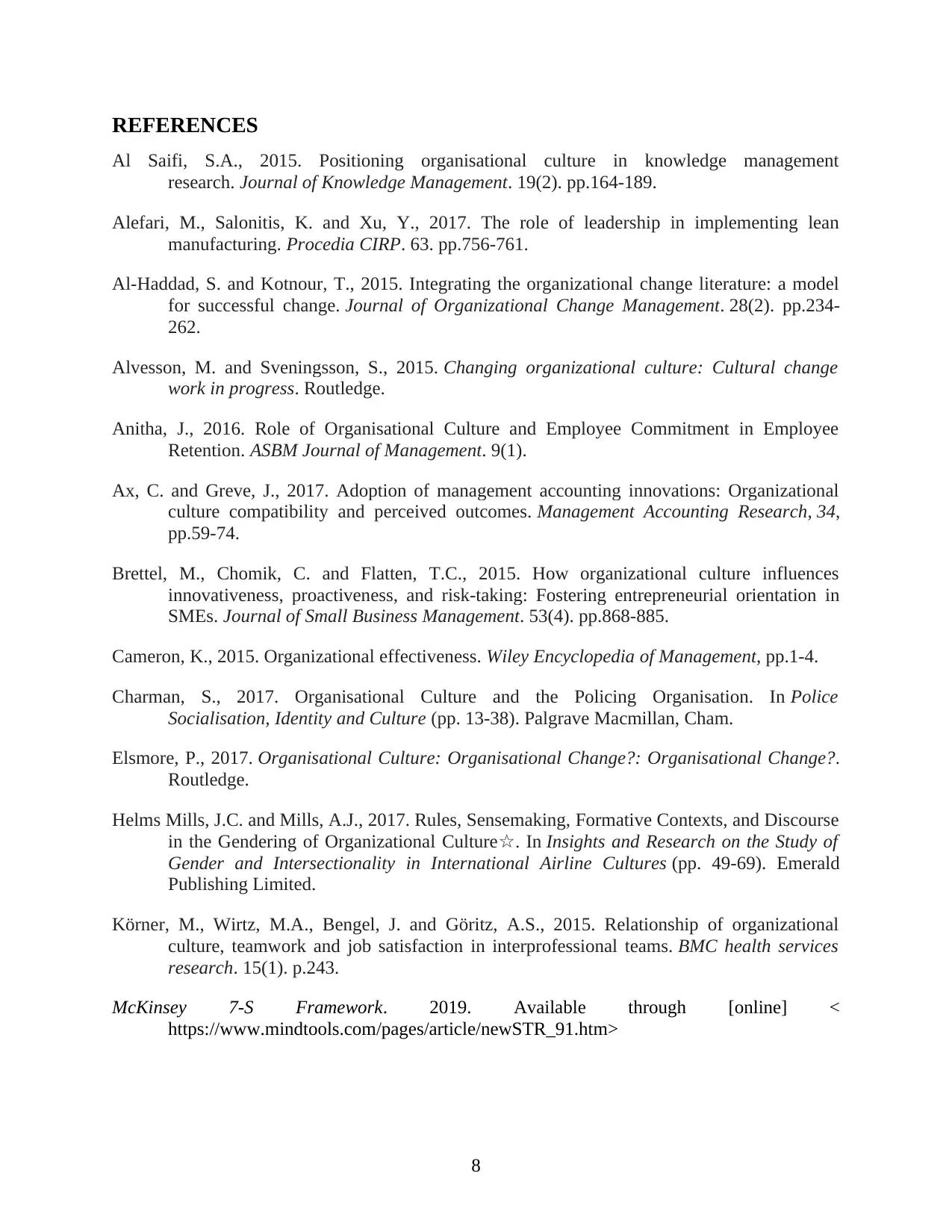
REFERENCES
Al Saifi, S.A., 2015. Positioning organisational culture in knowledge management
research. Journal of Knowledge Management. 19(2). pp.164-189.
Alefari, M., Salonitis, K. and Xu, Y., 2017. The role of leadership in implementing lean
manufacturing. Procedia CIRP. 63. pp.756-761.
Al-Haddad, S. and Kotnour, T., 2015. Integrating the organizational change literature: a model
for successful change. Journal of Organizational Change Management. 28(2). pp.234-
262.
Alvesson, M. and Sveningsson, S., 2015. Changing organizational culture: Cultural change
work in progress. Routledge.
Anitha, J., 2016. Role of Organisational Culture and Employee Commitment in Employee
Retention. ASBM Journal of Management. 9(1).
Ax, C. and Greve, J., 2017. Adoption of management accounting innovations: Organizational
culture compatibility and perceived outcomes. Management Accounting Research, 34,
pp.59-74.
Brettel, M., Chomik, C. and Flatten, T.C., 2015. How organizational culture influences
innovativeness, proactiveness, and risk‐taking: Fostering entrepreneurial orientation in
SMEs. Journal of Small Business Management. 53(4). pp.868-885.
Cameron, K., 2015. Organizational effectiveness. Wiley Encyclopedia of Management, pp.1-4.
Charman, S., 2017. Organisational Culture and the Policing Organisation. In Police
Socialisation, Identity and Culture (pp. 13-38). Palgrave Macmillan, Cham.
Elsmore, P., 2017. Organisational Culture: Organisational Change?: Organisational Change?.
Routledge.
Helms Mills, J.C. and Mills, A.J., 2017. Rules, Sensemaking, Formative Contexts, and Discourse
in the Gendering of Organizational Culture☆. In Insights and Research on the Study of
Gender and Intersectionality in International Airline Cultures (pp. 49-69). Emerald
Publishing Limited.
Körner, M., Wirtz, M.A., Bengel, J. and Göritz, A.S., 2015. Relationship of organizational
culture, teamwork and job satisfaction in interprofessional teams. BMC health services
research. 15(1). p.243.
McKinsey 7-S Framework. 2019. Available through [online] <
https://www.mindtools.com/pages/article/newSTR_91.htm>
8
Al Saifi, S.A., 2015. Positioning organisational culture in knowledge management
research. Journal of Knowledge Management. 19(2). pp.164-189.
Alefari, M., Salonitis, K. and Xu, Y., 2017. The role of leadership in implementing lean
manufacturing. Procedia CIRP. 63. pp.756-761.
Al-Haddad, S. and Kotnour, T., 2015. Integrating the organizational change literature: a model
for successful change. Journal of Organizational Change Management. 28(2). pp.234-
262.
Alvesson, M. and Sveningsson, S., 2015. Changing organizational culture: Cultural change
work in progress. Routledge.
Anitha, J., 2016. Role of Organisational Culture and Employee Commitment in Employee
Retention. ASBM Journal of Management. 9(1).
Ax, C. and Greve, J., 2017. Adoption of management accounting innovations: Organizational
culture compatibility and perceived outcomes. Management Accounting Research, 34,
pp.59-74.
Brettel, M., Chomik, C. and Flatten, T.C., 2015. How organizational culture influences
innovativeness, proactiveness, and risk‐taking: Fostering entrepreneurial orientation in
SMEs. Journal of Small Business Management. 53(4). pp.868-885.
Cameron, K., 2015. Organizational effectiveness. Wiley Encyclopedia of Management, pp.1-4.
Charman, S., 2017. Organisational Culture and the Policing Organisation. In Police
Socialisation, Identity and Culture (pp. 13-38). Palgrave Macmillan, Cham.
Elsmore, P., 2017. Organisational Culture: Organisational Change?: Organisational Change?.
Routledge.
Helms Mills, J.C. and Mills, A.J., 2017. Rules, Sensemaking, Formative Contexts, and Discourse
in the Gendering of Organizational Culture☆. In Insights and Research on the Study of
Gender and Intersectionality in International Airline Cultures (pp. 49-69). Emerald
Publishing Limited.
Körner, M., Wirtz, M.A., Bengel, J. and Göritz, A.S., 2015. Relationship of organizational
culture, teamwork and job satisfaction in interprofessional teams. BMC health services
research. 15(1). p.243.
McKinsey 7-S Framework. 2019. Available through [online] <
https://www.mindtools.com/pages/article/newSTR_91.htm>
8
Paraphrase This Document
Need a fresh take? Get an instant paraphrase of this document with our AI Paraphraser
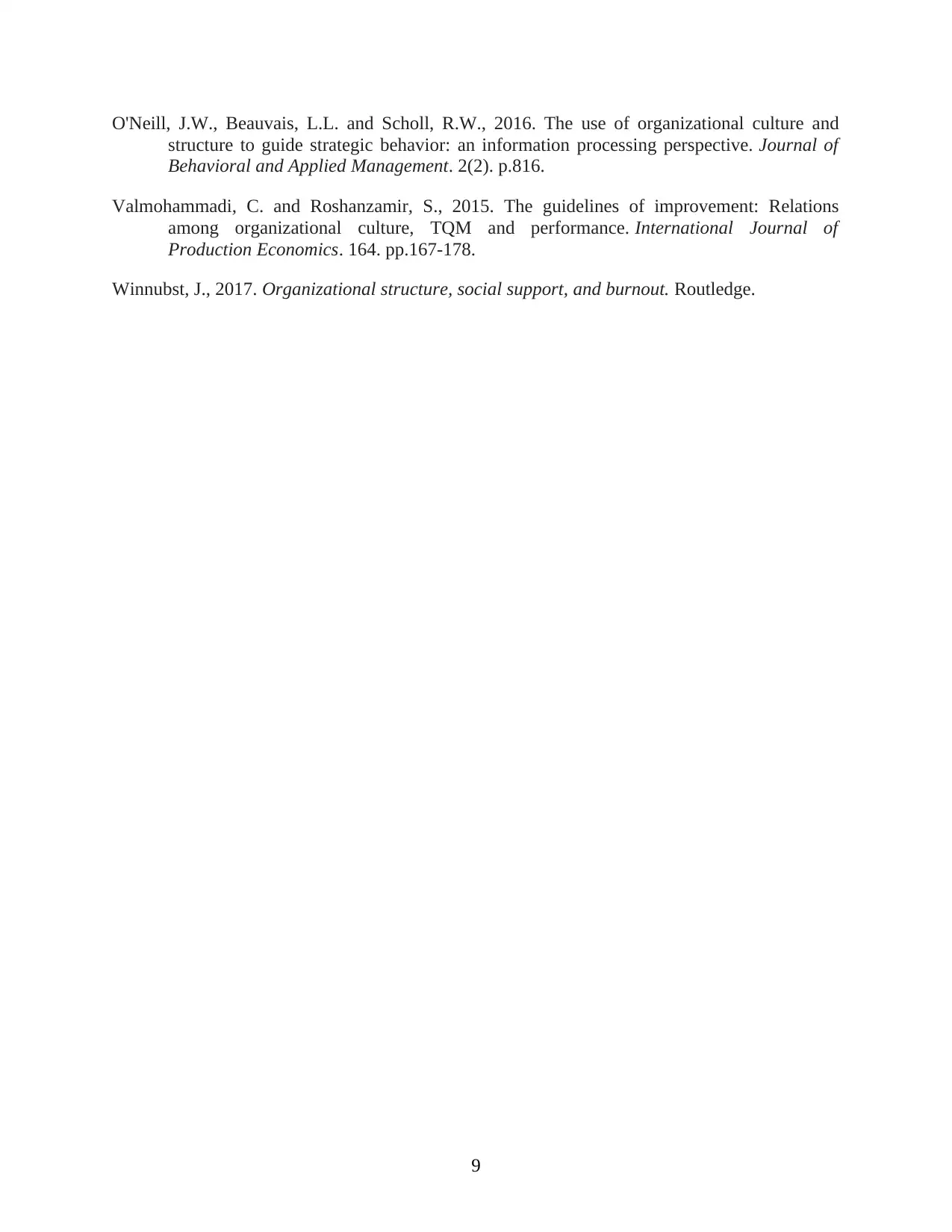
O'Neill, J.W., Beauvais, L.L. and Scholl, R.W., 2016. The use of organizational culture and
structure to guide strategic behavior: an information processing perspective. Journal of
Behavioral and Applied Management. 2(2). p.816.
Valmohammadi, C. and Roshanzamir, S., 2015. The guidelines of improvement: Relations
among organizational culture, TQM and performance. International Journal of
Production Economics. 164. pp.167-178.
Winnubst, J., 2017. Organizational structure, social support, and burnout. Routledge.
9
structure to guide strategic behavior: an information processing perspective. Journal of
Behavioral and Applied Management. 2(2). p.816.
Valmohammadi, C. and Roshanzamir, S., 2015. The guidelines of improvement: Relations
among organizational culture, TQM and performance. International Journal of
Production Economics. 164. pp.167-178.
Winnubst, J., 2017. Organizational structure, social support, and burnout. Routledge.
9
1 out of 11
Related Documents
Your All-in-One AI-Powered Toolkit for Academic Success.
+13062052269
info@desklib.com
Available 24*7 on WhatsApp / Email
![[object Object]](/_next/static/media/star-bottom.7253800d.svg)
Unlock your academic potential
Copyright © 2020–2025 A2Z Services. All Rights Reserved. Developed and managed by ZUCOL.





